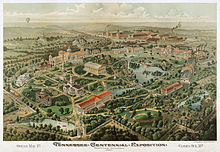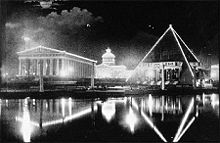Tennessee Centennial and International Exposition
| Tennessee Centennial and International Exposition | |
|---|---|
 Chromolithograph of bird's-eye view of the expo grounds | |
| Overview | |
| BIE-class | Unrecognized exposition |
| Name | Tennessee Centennial and International Exposition |
| Building | More than 100 buildings |
| Area | 200 acres |
| Visitors | 1,786,714 |
| Location | |
| Country | United States |
| City | Nashville |
| Venue | now Centennial Park |
| Timeline | |
| Opening | May 1, 1897 |
| Closure | October 31, 1897 |
The Tennessee Centennial and International Exposition was an exposition held in Nashville from May 1 – October 31, 1897 in what is now Centennial Park. A year late, it celebrated the 100th anniversary of Tennessee's entry into the union in 1796.[1] President William McKinley officially opened the event from the White House, where he pressed a button that started the machinery building at the fair; he would visit in person a month later.
Description[]
The site covered about 200 acres, and a characteristic feature of the landscape plan was the sward planted with the famous blue grass of the region. The buildings, of which there were over a hundred, included those devoted to agriculture, commerce, education, fine arts, history, machinery, minerals and forestry, and transportation, as well as those in which the special exhibits pertaining to children, African Americans, the United States Government, and women were shown. The total attendance was 1,786,714, of which the total paid attendance was 1,166,692. The total receipts were $1,101,285 (equivalent to $30 million in 2019[2]), and the disbursements $1,101,246 (equivalent to $30 million in 2019[2]).[3]

Many cities and organizations built buildings and exhibit halls on the Exposition grounds, conveniently located on the streetcar line on the western fringe of the city. Among the most prominent were those of Nashville itself, and its nearby rival, Memphis. Nashville designed its pavilion after the Parthenon in Greece due to the city's nickname as The Athens of the South. Memphis's exhibit, in honor of its Egyptian name, was a large pyramid. The Parthenon is the only structure to survive the Exposition and remains a tourist attraction to this day. Major Eugene Castner Lewis was the director general of the Tennessee Centennial Exposition[4] and it was at his suggestion that a reproduction of the Parthenon be built in Nashville to serve as the centerpiece of Tennessee’s Centennial Celebration. Lewis also served as the chief civil engineer for the Nashville, Chattanooga and St. Louis Railroad. Nashville's temporary Parthenon was reconstructed in permanent materials in a project lasting from 1920 to 1931 and still stands today as an art gallery on the original exposition grounds, which became Centennial Park.
Other attractions on the grounds were the Negro Building,[5] gondolas on Lake Watauga (still a feature of the park) and the Egyptian Pavilion. with its belly dancers. The Centennial Exposition was a great success and is still considered one of the most notable events ever to be held in the state. Unlike most World's Fairs, it did not lose money, although the final accounting showed a direct profit of less than $50.
Later Developments[]
The original Parthenon replica built for the exhibition was made of temporary materials and quickly began to deteriorate. Due to popular sentiment, the building was rebuilt with permanent construction. This version still stands and serves as an art museum housing Alan LeQuire's 1990 re-creation of the Athena Parthenos statue. The 1982 World's Fair was held in Knoxville, Tennessee.
References[]
- ^ "TeVA: Tennessee Centennial Exposition". cdm15138.contentdm.oclc.org. Retrieved 2021-10-29.
- ^ a b Thomas, Ryland; Williamson, Samuel H. (2020). "What Was the U.S. GDP Then?". MeasuringWorth. Retrieved September 22, 2020. United States Gross Domestic Product deflator figures follow the Measuring Worth series.
- ^ This article incorporates text from a publication now in the public domain: . New International Encyclopedia. 1905.
- ^ "Organ Recital in Memory of Maj. E. C. Lewis". The Tennessean. 1918-11-11. p. 3. Retrieved 2021-10-29.
- ^ "Negro Building". teva.contentdm.oclc.org. Retrieved 2021-10-29.
External links[]
- Tennessee Virtual Archive -- Tennessee Centennial Exposition—Collection of photographs and sheet music as well as aspects of the history of the exhibition
- Nashville Parthenon Official Website
Further reading[]
- Cardon, Nathan. "The South's 'New Negroes' and African American Visions of Progress at the Atlanta and Nashville International Expositions, 1895-1897" Journal of Southern History (2014).
- Cardon, Nathan. A Dream of the Future: Race, Empire, and Modernity at the Atlanta and Nashville World's Fairs (Oxford University Press, 2018).
- Justi, Official History of the Tennessee Centennial Exposition (Nashville, 1898).
- Tennessee Centennial and International Exposition
- 1897 in Tennessee
- Events in Nashville, Tennessee
- History of Nashville, Tennessee
- 1897 festivals
- May 1897 events
- June 1897 events
- July 1897 events
- August 1897 events
- September 1897 events
- October 1897 events
- 19th century in Nashville, Tennessee